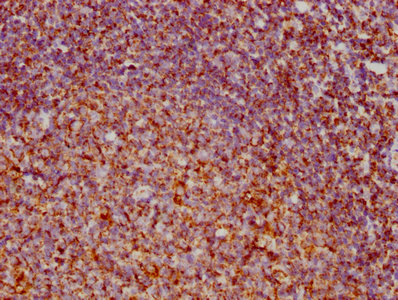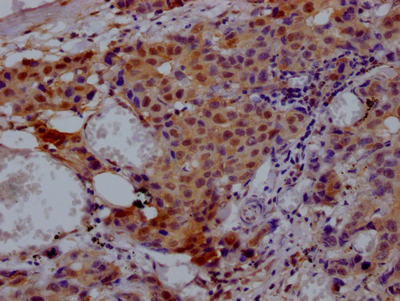GPR143 Antibody
-
货号:CSB-PA020179
-
规格:¥880
-
其他:
产品详情
-
Uniprot No.:P51810
-
基因名:GPR143
-
别名:GPR143; OA1; G-protein coupled receptor 143; Ocular albinism type 1 protein
-
宿主:Rabbit
-
反应种属:Human,Mouse
-
免疫原:Synthesized peptide derived from the Internal region of Human GPR143.
-
免疫原种属:Homo sapiens (Human)
-
标记方式:Non-conjugated
-
抗体亚型:IgG
-
纯化方式:The antibody was affinity-purified from rabbit antiserum by affinity-chromatography using epitope-specific immunogen.
-
浓度:It differs from different batches. Please contact us to confirm it.
-
保存缓冲液:Liquid in PBS containing 50% glycerol, 0.5% BSA and 0.02% sodium azide.
-
产品提供形式:Liquid
-
应用范围:IF, ELISA
-
推荐稀释比:
Application Recommended Dilution IF 1:200-1:1000 ELISA 1:10000 -
Protocols:
-
储存条件:Upon receipt, store at -20°C or -80°C. Avoid repeated freeze.
-
货期:Basically, we can dispatch the products out in 1-3 working days after receiving your orders. Delivery time maybe differs from different purchasing way or location, please kindly consult your local distributors for specific delivery time.
相关产品
靶点详情
-
功能:Receptor for tyrosine, L-DOPA and dopamine. After binding to L-DOPA, stimulates Ca(2+) influx into the cytoplasm, increases secretion of the neurotrophic factor SERPINF1 and relocalizes beta arrestin at the plasma membrane; this ligand-dependent signaling occurs through a G(q)-mediated pathway in melanocytic cells. Its activity is mediated by G proteins which activate the phosphoinositide signaling pathway. Plays also a role as an intracellular G protein-coupled receptor involved in melanosome biogenesis, organization and transport.
-
基因功能参考文献:
- Three novel mutations, c.333_360+14del42insCTT, c.276G>A (p.W92X), and c.793C>T (p.R265X), were identified in GPR143 by PCR followed by Sanger sequencing in members of families with X-linked ocular albinism. PMID: 28211458
- The findings of the present study expanded the gene mutation spectrum of GPR143 and investigated the clinical phenotype of patients with OA1 in the Chinese population. PMID: 28339057
- c.758T>A mutation in exon 6 of the GPR143 gene is associated with X-linked ocular albinism. PMID: 28397224
- Our results expand the spectrum of GPR143 mutations causing CN and further confirm the role of GPR143 in the pathogenesis of CN. PMID: 27958203
- tyrosinase as a potential GPR143 binding protein opens new avenues for investigating the mechanisms that regulate pigmentation and neurogenesis. PMID: 27720922
- X-linked ocular albinism type I, characterized by developmental eye defects, results from GPR143 mutations PMID: 28632878
- This family was found to harbor a novel, likely pathogenic mutation in GPR143 resulting in a combined Stargart disease and heterozygous carrier phenotype in the affected sisters . PMID: 27367509
- Here, we report a Chinese trio-family with the son who was affected by the X-linked ocular albinism in which a novel missense mutation in the GPR143 was observed. PMID: 26547501
- Twenty Chinese patients, including 15 sporadic IN cases and 5 from X-linked IN families, were recruited and underwent molecular genetic analysis. We first performed PCR-based DNA sequencing of the entire coding region and the splice junctions of the FRMD7 and GPR143 genes in participants. PMID: 27036142
- Downstream signaling from GPR143 controls RPE secretion of pigment epithelium-derived factor (PEDF), a potent neurotrophic and antiangiogenic factor. PMID: 26741053
- Five mutations in GPR143 gene were detected in each of the five families, including a novel nonsense mutation of c.333G>A,two novel splicing mutations of c.360+1G>C and c.659-1G>A, a novel small deletion mutation of c.43_50dupGACGCAGC. PMID: 26160353
- intronic mutation that creates a cryptic splice-donor site in GPR143 of patients with ocular albinism PMID: 26061757
- The GPR143 gene analysis identified an identical point mutation in two Ocular albinism 1 patients and their mothers . PMID: 24526317
- Melanosome-autonomous regulation of size and number: the OA1 receptor sustains PMEL expression. PMID: 24650003
- OA1 is involved in melanoma cell migration and that OA1induced melanoma cell migration is mediated through the RAS/RAF/MEK/ERK signaling pathway. PMID: 24736838
- a novel splicing site mutation of the GPR143 gene was found in a Han Chinese congenital ocular albinism pedigree. PMID: 24301936
- Data report that p.Y269X mutation of GPR143 gene is responsible for the pathogenesis of familial ocular albinism. PMID: 22916221
- Four patients with X-linked ocular albinism type 1 were identified from a cohort of 15 boys with clinical signs of albinism using mutation detection methods. PMID: 22486324
- These results identify the Oa1 transducer Galphai3 as the first downstream component in the Oa1 signaling pathway. PMID: 21931697
- The ocular albinism type 1 (OA1) GPCR is ubiquitinated and its traffic requires endosomal sorting complex responsible for transport (ESCRT) function. PMID: 21730137
- TYR gene mutations have a more severe effect on pigmentation than mutations in OCA2 and the GPR143 gene. Nevertheless, mutations in these genes affect the development of visual function either directly or by interaction with other genes like MC1R. PMID: 21541274
- A novel causative mutation of GPR143 was identified in a five-generation Chinese family with X-linked ocular albinism. PMID: 21423867
- TYR gene mutations represent a relevant cause of oculocutaneous albinism in Italy, whereas mutations in P present a lower frequency. Clinical analysis revealed that the severity of the ocular manifestations depends on the degree of retinal pigmentation. PMID: 20861488
- This is the first report of a Japanese X-linked ocular albinism (XLOA) patient with a GPR143 mutation. PMID: 21348135
- L-DOPA activates GPR143 signaling through a Gq pathway, while dopamine inhibits the receptor. PMID: 18828673
- we describe the first Spanish family known to present with X linked ocular albinism due to mutations in the OA1 gene PMID: 20649618
- OA1 interacts with MART-1 at early stages of melanogenesis to control melanosome identity and composition. PMID: 19717472
- Review: mutational analysis in ocular albinism type 1 PMID: 11793467
- OA1 has been immunologically characterized as an antigen that is expressed, processed, and presented in an MHC-restricted fashion by melanoma cells, but for which there is the human equivalent of a "knockout"--i.e., complete deletion in a male patient. PMID: 12538723
- Mutations in the OA1 gene is associated with ocular albinism PMID: 12868035
- Mutational analysis of the OA1 ocular albinism gene. PMID: 16646960
- No correlation was identified between congenital nystagmus and ocular albinism 1(OA1) gene. PMID: 16754205
- Our results indicate that a mutation in the GPR143 gene can cause a variant form of ocular albinism, with congenital nystagmus as the most prominent and only consistent finding in all patients in this Chinese family. PMID: 17516023
- eight new mutations located in the coding region of the gene are identified. PMID: 17822861
- Two novel mutations in OA1 gene were identified in two families with ocular albinism. Identified mutations are likely loss-of-function mutations. Mutations in OA1 gene are associated with majority of X-linked ocular albinism cases. PMID: 17960122
- These results indicate that this novel GPR143 mutation is associated with the congenital nystagmus observed in this Chinese family. PMID: 18523664
- Panretinal function in OA1 is within normal limits at all ages, consistent with previous reports in generalized albinism. PMID: 18798082
- Results illustrate an autocrine loop between OA1 and tyrosinase linked through L-DOPA, and this loop includes the secretion of at least one very potent retinal neurotrophic factor. PMID: 18828673
- These results expand the mutation spectrum of GPR143, and demonstrate the clinical characteristics of OA1 among the Chinese. PMID: 18978956
- The novel mutation p.G315X in the OA1 gene was identified in a Chinese family with ocular albinism, which is predicted to generate a premature stop codon. PMID: 19123159
- Results suggest that this novel mutation in GPR143 is associated with the congenital nystagmus observed in this Chinese family. PMID: 19390656
- Our results confirm that GPR143 is the major locus for X_linked ocular albinism and that exon 2 is a region of high susceptibility to deletions. PMID: 19604113
- A Chinese family with X-linked ocular albinism and partial deletion of GPR143, is reported. PMID: 19610097
显示更多
收起更多
-
相关疾病:Albinism ocular 1 (OA1); Nystagmus congenital X-linked 6 (NYS6)
-
亚细胞定位:Melanosome membrane; Multi-pass membrane protein. Lysosome membrane; Multi-pass membrane protein. Apical cell membrane; Multi-pass membrane protein.
-
蛋白家族:G-protein coupled receptor OA family
-
组织特异性:Expressed at high levels in the retina, including the retinal pigment epithelium (RPE), and in melanocytes. Weak expression is observed in brain and adrenal gland.
-
数据库链接:
HGNC: 20145
OMIM: 300500
KEGG: hsa:4935
STRING: 9606.ENSP00000417161
UniGene: Hs.74124
Most popular with customers
-
YWHAB Recombinant Monoclonal Antibody
Applications: ELISA, WB, IF, FC
Species Reactivity: Human, Mouse, Rat
-
Phospho-YAP1 (S127) Recombinant Monoclonal Antibody
Applications: ELISA, WB, IHC
Species Reactivity: Human
-
-
-
-
-
VDAC1 Recombinant Monoclonal Antibody
Applications: ELISA, WB, IHC
Species Reactivity: Human, Mouse, Rat
-
VCP Recombinant Monoclonal Antibody
Applications: ELISA, WB, IHC, IF, IP
Species Reactivity: Human, Rat




















